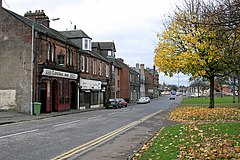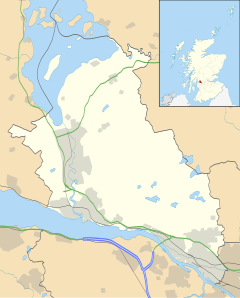This article has multiple issues. Please help improve it or discuss these issues on the talk page. (Learn how and when to remove these messages)
|
Renton
| |
|---|---|
 Main Street in Renton Main Street in Renton | |
 | |
| Population | 2,350 (2022) |
| OS grid reference | NS3878 |
| Civil parish | |
| Council area | |
| Lieutenancy area | |
| Country | Scotland |
| Sovereign state | United Kingdom |
| Post town | DUMBARTON |
| Postcode district | G82 |
| Dialling code | 01389 |
| Police | Scotland |
| Fire | Scottish |
| Ambulance | Scottish |
| UK Parliament | |
| Scottish Parliament | |
| 55°58′16″N 4°35′02″W / 55.971°N 04.584°W / 55.971; -04.584 | |
Renton (Scottish Gaelic: An Reantan; Scots: The Renton) is a village in West Dunbartonshire, in the west Central Lowlands of Scotland. In the 2001 National Census it had a population of 2,138.
Renton is particularly famous for the village's association football side. Renton was one of the 11 founder members of the Scottish Football League and winners of the 1885 and 1888 Scottish Cup, producing many famous players.
History
The Renton takes its name from Cecilia Renton (daughter-in-law of Tobias Smollett) after whom the modern sandstone, 'model' village was named in 1762. Dalquhurn Bleachworks in 1715 and Cordale Printworks in 1770 were responsible for attracting new industrial workers. At the north of the village stood the Place of Bonhill, a residence from 1642, to the South was Dalquhurn House. Two parallel north–south streets, Main Street and Back Street were first joined by Station Street, Stirling Street, Burns Street, Thimble Street, Market Street and Red Row. In late Victorian times, the village extended southwards to Leven Street, Alexander Street and John Street. Further expansion occurred in the 1930s as housing was built in the grounds of Cordale House. In the early 1960s the majority of the sandstone properties in the village were compulsory purchased by Dumbarton County Council, demolished and replaced by Dumbarton County Council with 1960s Brutalist-style concrete houses and flats; the majority of which have been replaced by proper houses, own front & back door, by the Cordale Housing Association.
It has traditionally been a stronghold of radical left-wing politics; during the 1930s it had Communist councillors, Bunger Lamont, never toed the Labour Party line and independent councillors such as Jimmy McKenzie (1960/70s), and since 1999 it has been represented on West Dunbartonshire council by Jim Bollan, at present the Scottish Socialist Party's only councillor.
It lies on the main road, A82 as was, between Alexandria and Dumbarton. Renton railway station is on the line from Glasgow to Balloch. It has a footbridge across the River Leven to the Strathleven Industrial Estate (once a major source of employment), and a minor road, with a steep 33% hill, across Carman Hill to Cardross.
Robert the Bruce's manor house
Despite a report that appeared in The Observer on Sunday 22 February 2009(1) stating that the buried ruins of the manor house of Robert the Bruce had been found in the Pillanflatt area of Renton, this interpretation has yet to be confirmed. While there is strong Charter evidence to indicate the presence of a manor or hunting lodge belonging to Bruce in the area, this is more likely to have been located in the vicinity of Mains of Cardross, to the south of the Pillanflat, rather than in the area to the north of it. Stone, plaster and mortar are not generally susceptible to scientific dating techniques, and lime mortar was used from the Roman period up to the late 19th or early 20th centuries.
According to Bruce Historian Stuart Smith, a charter dating from 1362 charter states that Robert the Bruce resided between Kings Park of Cardross and the lands of Pillanflatt, bounding the lands of Dalquhurn. This would suggest a site to the south of the Pillanflat, but to the north of Castle Park, in the vicinity of what is now Mains of Cardross.
Modern Times
In recent times, Renton has seen some major social regeneration most notably, although not restricted to, housing.
Notable residents
- Jack Ashurst, footballer
- Robert the Bruce, King Of Scotland
- Jane Duncan, author
- Andy Duncan, footballer
- Sir Alex Ferguson: Both his grandfather & father were born in Renton & worked in the shipyard in Dumbarton. The family moved to Linthouse near Govan to gain employment in the Govan shipyard.
- Skeets Gallacher, boxer
- James Allison Glen, Canadian politician
- Andrew Hannah, footballer
- Alex Jackson, footballer
- James Kelly, footballer
- Duncan McLaren, Scottish politician
- John O'Hare, footballer
- Tobias Smollett, writer and surgeon
- William Wilson, Australian politician
Sport
When Renton F.C. won the World Cup, the footballing world was in its infancy in 1888, almost exclusively played by Scottish and English clubs. It was a World Cup Championship by default – nevertheless Renton's claim is undisputed. They won the Scottish Cup with a 6-1 thrashing of Cambuslang F.C. Then they humbled English Cup holders West Bromwich Albion, who had prepared in Scotland for two weeks. The score was 4–1 in front of a record 10,000 fans at Hampden Park. Renton endorsed their title with an away win against "The Invincibles" of Preston North End. A "Champion of the World" sign was proudly displayed on the pavilion at Tontine Park. They are one of the few teams to have their name engraved on the Scottish Cup multiple times (2 wins), They were ahead of their time in training for stamina and strength. Their weapon was Renton's own famous "chicken bree", the ingredients never disclosed but it was probably port wine switched with a couple of eggs administered daily.
Quoiting (pronounced kiteing) was a popular sport amongst the male villagers. Quoiting greens were found in Renton, Alexandria, Hardgate and many Ayrshire villages. Quoits were heavy iron rings, rounded on one side, flat on the other and weighed 8–12 pounds (3.5–5.5 kilograms) but could be up to 23 pounds (10 kilograms). They were hurled at a steel pin driven into a 3-foot (90-centimetre) square clay bed, with the common length of the green being 18 yards (16 metres). Renton were Scottish Champions in 1949 and 1986. There is a photograph of the victorious 1949 team in Renton Railway Station.
Facilities
There are several recreational and consumer-related facilities in Renton, including a new mini supermarket and healthy living centre. There is a bowling green and a Freemasons lodge.
Wylie Park (known locally as Tontine Park ) is also used most Saturdays and Sundays for football games. It is home to local youth football team Renton Craigandro.
There is a youth club at the Autism and Aspergers Centre (old nursery) every Wednesday, 6pm-7:30pm for Primary 1 to 6 and 7:30pm-9pm for 1st, 2nd and 3rd Years at high school.
Footnotes
- "Mid-2020 Population Estimates for Settlements and Localities in Scotland". National Records of Scotland. 31 March 2022. Retrieved 31 March 2022.
- Holmes, Robin (2020). Forgotten Scotland's Former Football League Clubs.
- Kelbie, Paul (22 February 2009). "Lost and found: 14th century palace of Robert the Bruce in West Dunbartonshire". Science. Guardian. The Observer. Retrieved 22 March 2009.
References
- Jim Murphy (28 September 2007). Renton: Between the Wars 1914-18 and 1939-45. Carman Centre. ISBN 978-0-9557511-0-3.
External links
| Settlements in West Dunbartonshire | |
|---|---|
| Towns | |
| Villages and suburbs | |